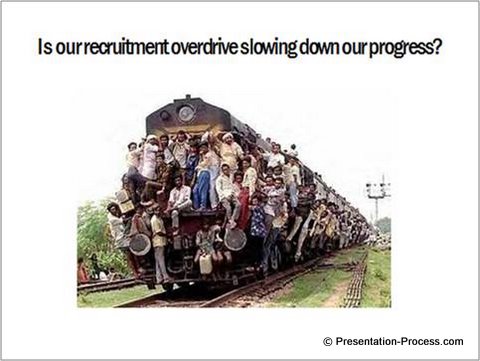Home > How to Present > Using Presentation Humor
Is it appropriate to use humor in business presentations? Won’t you look silly when it doesn’t work? Discover 3 things that make humor work in business presentations.
Let us not confuse telling jokes in a presentation with using humor.
We are definitely not in favor of using jokes in business presentations. No matter how good you are, you can’t start your critical presentation with “One day a man entered a bar…” and then expect your audience to take the rest of the presentation seriously.
Humor in presentations is about connecting with the emotions of your audience and making them see the ‘other’ side of issues with objectively. When used correctly it increases the effectiveness of your message.
This article is about using humor to add impact to your message and not about making your audience roll in the aisles.
Your humor needs to have 3 essential traits to work in a business presentation:
- It needs to be contextual
- It needs to ‘ring a bell’
- It needs to be personal
Let us understand each of these in detail.
1. Humor needs to be contextual:
The effectiveness of your wit depends on how relevant it is and how well it fits in with the context of your presentation.
I recently saw a HR presentation where the business head made a fairly strong point with this slide:

They are an outsourcing company and they had been on a frantic drive to increase headcount to impress their overseas client. The sudden spurt in staff numbers has naturally dented the profitability of the company.
This picture of overcrowded train crawling along the tracks aptly portrayed the company’s current situation. The slide not only evoked laughter, but also made the audience realize (and remember) the nature of the situation they are in.
The slide is a good example for using contextual humor. Unlike a joke that ‘fails’ when it doesn’t evoke a laugh, good humor doesn’t‘fail’. Even if the audience doesn’t laugh, the point is made. It allows the presenter to move on with the presentation, without unduly worrying about the audience response.
2. Humor needs to ‘ring a bell’
Good humor ‘connects’ with the audience instantly.
I recently saw a presentation made by the manager of a document processing team in a bank. He wanted to share his concerns about the increased work load on the team during month ends.
He used a slide that immediately struck a chord with his colleagues.

The slide didn’t need a lot of explanations. The team could immediately feel the frustration experienced by the presenter. The discussion quickly moved forward to solving the capacity issues.
Here is another simple and powerful image we use in our presentations skills training program. We talk about the common bad habits that presenters have of putting together slides from different presentations to create their presentations.
We show this slide as the result of such cut-paste methods of creating presentations:

See the training program video here >>
The point and the image always draw a laugh and our audience get ready to address this issue instead of getting offended.
Appropriate use of humor helped the presenter to convert a potential mudslinging session into a ‘problem resolution’ session. That is the power of presentation humor.
To make it work, you need to know your audience thoroughly. When you talk their ‘language’, feel their concerns – they connect to you. They don’t take offense even if your humor misses the mark. They take the effort to see your point.
3. Humor needs to be personal:
It is always safe to direct the humor towards yourself. This ensures that your presentation humor doesn’t come across as sarcasm – even if you cross the line unintentionally.
When you relate your personal experience you come across as ‘real’. Your problems feel real. Your solutions feel real.
To tell a joke, you may need impeccable ‘sense of timing’. To use good personal humor, you just need to feel the situation and tell it the way you experienced it. So, humor is easier to practice than a joke.
- Save anecdotes of personal experiences in a resources folder to be used later
- Make a list of your audience’s frustrations to relate to them quickly
- Practice connecting your humor to presentation context. This will ensure that you don’t lose your audience after they finish laughing.
Using humor in presentations is no ‘laughing matter’. It requires conscious effort and practice. But the impact you create is worth the effort.
…do share it with your friends and introduce them to this site. There is a treasure of useful information here to help improve your business presentations.
Related: : How to use Full Page Images Correctly in PowerPoint
Return to Top of Using Presentation Humor Page
